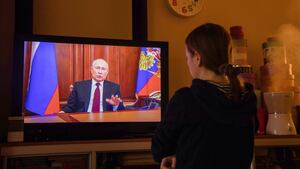In the information era, a lie can make its way around the world and, in short order, make millions of people sympathetic to an unjustifiable war of aggression.
False claims that Russia has been targeting sinister U.S.-backed “biolabs” in Ukraine were popularized among conspiratorial American audiences by QAnon believers shortly after Russia launched its invasion in late February. Mainstream Republican voices have since dragged the old Russian propaganda at its roots across the forefront of the U.S. political stage.
The Kremlin has for years accused the U.S. of operating a shady network of biolabs in foreign countries conducting dangerous experiments, including some in Ukraine that have allegedly targeted unsuspecting locals. Though the U.S. does support medical and biodefense labs across the former Soviet Union, there is no evidence to support claims that the labs are used to develop bioweapons programs. China has peddled similar propaganda; it tag-teamed with Russia last year to rehash an old accusation that COVID-19 may have been manufactured in U.S.-supported labs—a narrative that has been nurtured by pro-Kremlin sources since the onset of the pandemic in 2020.
Kremlin media operations and officials resurfaced these lies as Russia was amassing its troops at Ukraine’s northern border, and again in early March (once the invasion was already underway) after its other justifications failed to stick. Government officials in the U.S. have explicitly denied the accusations.
As noted by fact checkers, these propaganda lines were regurgitated by U.S.-audience junk news blogs in late February shortly after Russia invaded Ukraine. Around the same time, a single QAnon supporter launched the false claims on their way to online virality after sharing an image of maps contrasting lab locations with Russian airstrike locations.
And now, the premise of this Kremlin accusation is being asserted and defended by some of the country’s most popular Trump-aligned media personalities, including America’s most-watched cable host Tucker Carlson, former presidential adult son Donald Trump Jr., and beanie-clad “disaffected liberal” YouTube creator Tim Pool. Former Rep. Tulsi Gabbard (MAGA’s favorite Democrat) got in on the take too, though she has walked back her claims somewhat after drawing criticism.
Reporting for Foreign Policy, journalist Justin Ling explained that these accusations are built off of two far-reaching assumptions: that COVID-19 was manufactured as a bioweapon and that the U.S. would only fund research labs in order to secretly produce such weapons. As thoughtless and evidence-free as those base claims may be, many online communities that traffic in conspiratorial content accepted those assumptions years ago. Whether they choose to blame billionaire George Soros, the “deep state,” or the “New World Order,” assertions that the coronavirus was made as a bioweapon to justify controlling the world’s population are abundantly common in anti-vaccine and other conspiratorial communities online.
Those claims about COVID-19’s origins and the virus’ supposed sinister utility to the world’s elite have fueled years of anti-mask, anti-mandate, and anti-vaccine activism in the U.S., including at protests and in the harassment of public health officials. COVID conspiracy theories’ ability to unify swaths of the anti-establishment GOP has established itself as a bridge uniting the furthest excesses of conservative politics with the most mainstream of its culture war causes.
It’s not evident that Russia initially formulated this specific grain of wartime propaganda for conspiratorial American audiences. Its lies about biolabs in Ukraine were likely circulated anew among domestic Russian audiences this year to build fear and support for its hostility toward Ukraine.
Regardless, those lies were turned into grist for the mills of the conspiracy-brained internet and partisan U.S. media programs that gleefully regurgitate such fare. That’s a win for the Kremlin’s war propaganda machine.
Eto Buziashvili, a research associate at the Atlantic Council’s Digital Forensic Research Lab (where we both work), has worked on a team tracking biolab rumors from Russian and Chinese sources for more than two years. She told me that while Russia first used narratives and disinformation related to biolabs to threaten or distract from its own actions, “now the narratives are one of main justifications of the invasion.” She added that Russian military officials have since presented forged documents as additional “proof” of those supposed justifications.
Though some experts and news headlines have already declared Russian propaganda efforts surrounding its invasion of Ukraine a flop, those declarations were perhaps premature.
Junk claims about biolabs have undeniably resonated with conspiratorial American audiences in ways that other Kremlin wartime propaganda has, thus far, failed. As Russian officials rehash the accusations again, folding U.S. audience interpretations of its longstanding narratives further into pro-invasion propaganda efforts, it is clear Moscow has identified the narrative as a potential winner.
Intentionally or not, conspiratorial influencers and audiences have contributed to a Russian disinformation campaign meant to justify its slaughter of Ukrainian civilians. The seeming inability or unwillingness of right-wing media groups to self-police against its excesses and worst tendencies have given the Kremlin a gift it is sure to leverage as it intensifies its campaign to justify those horrors.







